Top News
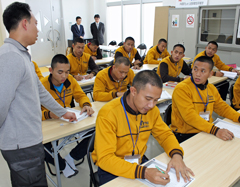
February 13, 2014 Ryukyu Shimpo
To accept foreign on-the-job trainees, the fisheries industry and farmers set up the Churashima Cooperative Union. The union accepted 13 trainees from Indonesia this month and began training programs such as Japanese language classes. It is the first time for a cooperative union in Okinawa to host foreign trainees. Trainees aim to receive the qualification Technical Intern Training II in a year. After receiving the qualification, the trainees will stay on for two years of on-the-job training. Using trained people, affiliated companies will consider starting businesses in Indonesia in future.
Nine out of 13 trainees will work in fisheries companies and four at chrysanthemum farms. After studying Japanese for three months in Indonesia and another Japanese lesson for three months at Sanko Suisan, the head office of the union, the trainees will start on-the-job training in March.
At Sanko Suisan, trainees will learn how to cut tuna and process squid. At the Izena Fisheries Cooperative, the trainees will use mozuku for training.
A 27-year-old trainee from Bali, I Komang Arsika said that he wanted to work at a farm in Okinawa and then become a Japanese language teacher in his home country. Eighteen-year-old Kholidin, who will work at the Izena Fisheries Cooperative, said that he wanted to create a fishing company back in Indonesia.
Trustee of the Union Kiyoshi Umazume commented, “The biggest merit is to have youthful workers. Working in the same position as Japanese workers is also beneficial for the trainees.”
Ten companies and individuals currently belong to the union. The union targeted the agricultural and fisheries industries. However, it added the food-processing industry after changing the rules of affiliation. The union receives inquiries from construction industries that have been short of workers. The union plans to increase the number of affiliate companies.
The union started in June 2012. It began accepting foreign technical intern trainees in fiscal 2013.
Domestic industries can accept foreign trainees through the Technical Intern Training Program for no more than three years. The Japanese government bans manual labor in the program. The government intends to increase foreign workers to allow for rapid construction ahead of the 2020 Tokyo Olympics.
(English translation by T&CT and Megumi Chibana)
Go to Japanese

February 16, 2014 Ryukyu Shimpo
The name of the Okinawa rail that the learning center in the Ada district of Kunigami Village has been raising is Kyonkyon. Six-year-old Riria Kinjo of Hentona Kindergarten came up with the name. The center invited children, including Kinjo to hold a ceremony on February 15. Kinjo named the bird after its chirping sound, “kyokyo.” She said, “I am happy to be able to name the bird. I want to tell my friends about it.”
Six children from Kunigami named the center “Forest of Kunina.”
The center called for people to name the bird on New Year’s cards and had 785 entries.
The mother of Kinjo said, “Encouraged by the teacher of the kindergarten, we came up with the name. We decided soon because we often heard the bird’s chirping sound around the house.” In the center, people can watch the birds living in the conditions similar to the natural environment.
(English translation by T&CT)
Go to Japanese
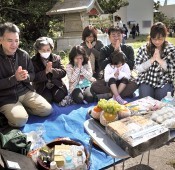
February 16, 2014 Ryukyu Shimpo
Okinawan people hold the Jurukunichi Festival or the New Year’s Day of the Dead on February 15 when is January 16 according to the Chinese calendar. In fine weather, more than ten families gathered to set tables on carpets in the Miegusuku district of Naha. They celebrated the New Year for ancestors by facing out to sea.
Seventy-four-year-old Nago resident Setsuko Shimajiri who came with her six family members, is from Miyako. She said, “More than 10 years have passed since the last time I celebrated the festival. I prayed for the health of my children and grandchildren this time.”
(English translation by T&CT)
Go to Japanese

February 17, 2014 Ryukyu Shimpo
Naha Airport opened a new international passenger terminal building on February 17. The opening ceremony took place in the building. The officials of the central and prefectural governments and representatives of the airlines celebrated the start of ‘a new gateway to foreign countries from Okinawa.’ Yoritaka Hanashiro, president of the Naha Airport Building Co., which manages and maintains the international building, said in her speech, “Okinawa will continue to develop as the gateway of Japan to Asia. We will strive to improve the international building more and more.” Ten airlines, including China Airlines (Taiwan) and Asiana Airlines (South Korea), will use the new international building. It operates 61 round trips a week between Naha and seven international destinations such as Seoul and Taipei.
Mamoru Otsubo, the head of the Naha Airport Office, Osaka Regional Civil Aviation Bureau of the Ministry of Land, Infrastructure and Transport, said, “The number of passengers on international routes at the airport has increased greatly in recent years. It is perfect timing to open the new international building. We expect that this terminal will contribute significantly to developing tourism and economic growth in Okinawa.”
A tourist who visited from Taiwan to take part in the resort wedding in Okinawa with 40 family members, said, “We came to Okinawa through the old international terminal on February 12. Now the new terminal operates. It has become more convenient.”
The old international building will be closed on February 16 and then removed by June.
(English translation by T&CT)
Go to Japanese
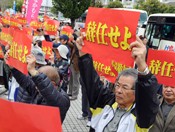
February 14, 2014 Ryukyu Shimpo
Last December Okinawa Governor Hirokazu Nakaima approved the landfill application for the replacement of the U.S. Futenma Air Station to Henoko, Nago. On February 14, a citizens group and four opposition parties of the Okinawa Prefectural Assembly held a rally to demand that the governor resign and withdraw his approval. About 2,000 protesters surrounded the Okinawa Prefectural Government building. The participants voiced their anger at the governor. One protester said, “Pledge-breaker governor should resign,” and another protester said, “No military bases is the will of the people.” They carried placards demanding his resignation and the withdrawal of his approval of the landfill. Opposition parties raised an urgent motion demanding the setting up of an investigative commission at the prefectural assembly to look into the governor’s decision in terms of Article 100 of the Local Autonomy Act. The regular meeting of the assembly opened on this day, but it stopped and started often because of the urgent motion.
In December last year, protest rallies around the government building were held twice to demand that the governor withdraw approval of the landfill. This is first time such a rally has occurred since on January 10 when the assembly adopted the resolution to demand the governor’s resignation. Participants gathered one after another in the square before noon. Students passing by, office workers during their lunch break and women who had rushed from all over Okinawa also joined the rally. They surrounded the government building for about half an hour.
Nana Yoshikawa, from Naha City, said, “Someone who ignores the voice of the citizens cannot be our leader. The central government is trying to force the landfill on the residents who do not wish to build a new base in Henoko. Does the government need so many military bases on Okinawa?”
Shigeo Nita, 79, from Itoman City, said, “The governor should resign from his job,” and added, “We must resist the arrogance of the governor. I want young people to visit Henoko.”
(English translation by T&CT)
Go to Japanese
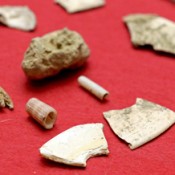
February 16, 2014 Ryukyu Shimpo
The Okinawa Prefectural Museum & Art Museum announced on February 15 that archaeologists have unearthed 39 items of shell tools, accessories and human bones in the Sakitari Cave in Nanjo City.
Carbon dating of charcoal from the same formation suggests that the remains date back 20,000 to 23,000 years, making them from the Upper Paleolithic age.
Researchers have unearthed shell tools dating back 2,000 to 10,000 years (the Jomon Period), but this is the first time in Japan that they have found the tools at the site from the Paleolithic Age.
It is possible that the Minatogawa people, the prehistoric people of Okinawa who lived about 18,000 years ago, used the tools. A representative of the museum said, “The findings are important to clarify Paleolithic culture. This is a rare find anywhere in the world.”

The location of Sakitari Cave.
According to the museum, the researchers unearthed 23 items of fragments of bivalve shells. The edged shells indicate that they were used to cut and scrape things. The researchers recognized tiny wounds caused by their use. The museum sees the tools as having been used for cutting cooking ingredients and manufacturing.
The researchers found two accessories made of tusk shell fragments. There were about 1.5 centimeters long in a cylindrical shape and appear to be beads.
They found a human tooth, a foot bone and crab claws, burned earth from the same formation.
On February 15, the museum opened the site to the press and explained the items were unearthed from the black geological formation that contained many carbides.
Shinji Yamasaki, a curator with the museum, said, “We think that people used to live around the site.” He went on to say, “Although the tools made of stone and bone in Paleolithic Age were not new experts, this is the first time that researchers have found the shell tools in this age. The findings will help clarify the culture of the Minatogawa people.”
The museum plans to display the items to the public from February 18 to March 16.
Excavation in the Sakitari Cave, which began in 2009, found human remains and stone artifacts dating back 12,000 years and earthenware dating back 9,000 years.
There is a possibility that the researchers will find items from older ages. The museum plans to continue researching in 2014.
Glossary: Sakitari Cave
A cave site in Nanjo City. The Okinawa Prefectural Museum & Art Museum started researching the site in 2009. The researchers found human remains and stone artifacts dating back 14,000 years. They also found the oldest piece of Okinawan earthenware with the Oshibiki pattern from 9,000 years ago.
The researchers expect further findings from older formation.
Go to Japanese

February 14, 2014 Ryukyu Shimpo
In Tokyo on February 13, Nago Mayor Susumu Inamine held a press conference at the Foreign Correspondents’ Club of Japan for the first time. He announced to visit the United States as early as April. Reelected in the mayoral election, Inamine intends to convey his opposition to the plan to move U.S. Marine Corps Air Station Futenma to the Henoko district in Nago to the U.S. government officials and intellectuals. He seeks their understanding. Inamine said, “I will visit the United States after April and tell many people about my intentions.”
He talked about his meeting with U.S. ambassador to Japan Caroline Kennedy who visited Okinawa. Inamine said that Kennedy showed interest in the sea off Henoko and the natural environment of Oura Bay where a diverse range of animals such as dugongs and sea turtles live.
Inamine again said that Kennedy did not specifically refer to the Henoko relocation.
Inamine said that his reelection last month reflected the desire of Nago citizens to prevent the building of a new military base in Henoko. He went on to say, “If the Japanese and U.S. governments force the plan through, they will be ignoring the will of the people. Democracies should accept the results of elections.” Inamine strongly criticized the Japanese government for promoting the plan despite the election result. He pointed out that Okinawa has been forced to endure the excessive burden of hosting the U.S. military for 68 years since the end of World War II. Inamine said, “It is discriminatory treatment.” Inamine continued, “I want foreign correspondents to be interested in the problems that Okinawa has been facing, and to tell people overseas.”
Inamine held a press conference at the Japan National Press Club for the first time. He said to the reporters, “Building the new base will damage tourism businesses and destroy the living and learning environment for children. The Henoko relocation is a human rights issue.” Inamine said that if the Japanese government sees the Japan-U.S. Security Treaty and Japan-U.S. alliance as important, other parts of Japan should take the burden of hosting the U.S. military bases.
(English translation by T&CT)
Go to Japanese

February 11, 2014 Ryukyu Shimpo
The Okinawa Zoo & Museum has announced on February 10 that 13-year-old Asian elephant Ryuka is pregnant. It is the first time that an elephant has become pregnant in Okinawa. She is scheduled to give birth around next March. Ten elephants have been born in Japan since the war. The people related to the zoo hope the elephant will be born in Okinawa for the first time.
Her “husband” is 11-year-old Ryuto, which came to the zoo from India with Ryuka in December 2007. The two elephants are around 20 years old in human years. Ryuka, the wife, is older than her “husband.”
Zoo staff saw the two elephants mating for the first time on May 17 last year. After that, they have seven times in four years.
An ultrasound examination carried out in February confirmed that Ryuka is pregnant. It is unclear whether the baby is male or female. A baby elephant weighs four kilograms, the same size as a cat.
Okinawa City Mayor Mitsuko Toman, who is the administrative director of the zoo, said, “Ryuto and Ryuka get on great. I expect to see a new baby.”
Visitors can see Ryuka walking around the zoo every afternoon. The zoo continues to hold exhibitions for visitors to touch Ryuka every Saturday and Sunday.
(English translation by T&CT)
Go to Japanese
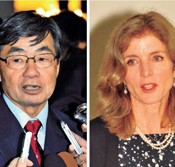
February 13, 2014 Ryukyu Shimpo
US Ambassador to Japan Caroline Kennedy held a meeting with Nago Mayor Susumu Inamine at a hotel in Naha in the afternoon of February 12. Inamine asked the ambassador to abandon the plan of moving the Futenma base to Henoko, Nago, saying, “I do not want to reclaim land off Henoko to build a new base.” Inamine said, the ambassador did not give a clear answer. However, according to the mayor, she said that she wants to visit Okinawa several more times to see it properly because she could only have a short time to visit a limited number of places this time. The mayor asked the ambassador to tell President Barack Obama that the people of Nago do not want the landfill for a new base. Kennedy responded that she understood that well, Inamine said.
Inamine explained that the result of the Nago mayoral election, in which he was reelected, clearly indicates the will of the citizens who are against building a new base. The mayor said that the ambassador did not say anything to seek his cooperation for the relocation plan to Henoko. The meeting between the two was not listed on Kennedy’s official schedule. The mayor received a suggestion for this from the U.S. side on February 12. The meeting was held in the evening of February 12 before a reception held at a hotel in Naha City hosted by the U.S. side.
Inamine explained the rich natural environment around the Henoko waters, where the endangered species of dugongs and coral reefs are found, and the scale of the new base planned for Henoko. He handed her a booklet in English, which describes the U.S. military base in Nago. However, there was no mention from Kennedy of specific matters such as the dugongs. After the meeting, Inamine said to the reporters, “Ambassador Kennedy listened with interest [to the explanation about dugongs and coral reef]. I had a good talk with her prior to her visiting Henoko.”
On February 13, Kennedy visited the US Marine Corps Air Station Futenma and Camp Schwab in Henoko. The ambassador arrived at Okinawa in the evening of February 11. At the meeting with Okinawa Governor Hirokazu Nakaima held on February 12 at the Okinawa Prefectural Government Office she stated that she will strive to reduce the burden of bases on Okinawa. At the Peace Memorial Park in Itoman, Ambassador Kennedy pledged to do all she can to promote the building of a better future for children and a more peaceful world. She visited Shuri Castle and interacted with the students of Shuri High School in Naha.
(English translation by T&CT)
Go to Japanese
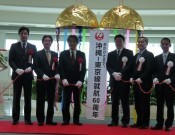
February 5, 2014 Ryukyu Shimpo
To commemorate the 60th anniversary of flights between Naha and Haneda, Japan Airlines (JAL) held a ceremony at the Naha Airport Domestic Terminal building in the morning of February 5.
Yoshiyuki Uehara, the head of the Okinawa Convention & Visitors Bureau, and Seijun Wakugawa, the director-general of the Department of Culture, Tourism and Sports of Okinawa, took part in the ceremony.
Miss Okinawa Green Gracious Chika Nago presented a bouquet of flowers to the president of the company, Yoshiharu Ueki.
Ueki said, “This was the fifth service that the company launched. The route is laden with history. We have been expanding the number of flights as Okinawa has developed. We would like to continue to advance with Okinawa.”
The company launched the flight as an international flight before Okinawa’s return to Japanese sovereignty in 1954. They used to run return flights two times a week. The company had about 2,500 people using the flight every year at the beginning. They currently run return flights 12 times a week, with about 3 million people using the service every year.
(English translation by T&CT)
Go to Japanese

February 6, 2014 Ryukyu Shimpo
In January 25, youth and child-raising people who oppose the plan to move Futenma Air Station to Henoko in Nago, set up a new group called “New Wave to Hope.” Centered around youth who feel angry about the approval of the Henoko landfill by Okinawa Governor Hirokazu Nakaima last December, the members have started to work on stopping the plan in their own way. The members are enthusiastic, saying, “We would like to create a ‘new wave.'”
The members are young people and child-raising people in their 20s to 40s. Kazue Nakamura-Huber, the co-leader of the group said, “We aim to let young people join freely and protest in their own way.”
Fumiya Oshiro and Yusuke Ichida, members of the group, are planning to film what they do using smartphones and stream it onto the Internet. Oshiro said, “By broadcasting what is happening in Okinawa, we would like people worldwide to think about the problems caused by the U.S. military bases.”
The members have various motivations for joining the group. Naoko Kinjo, who is from Henoko and has been bringing up her children, saw the news about the governor’s approval of the landfill. She thought, “If I don’t act for our children’s future right now, when should I?” She then joined the group. “I would like to express my thoughts to oppose the building of the base in my own way,” she said.
As their first action, they held a protest meeting against the U.S. Ambassador to Japan Caroline Kennedy on February 11 in the square of the Okinawa Prefectural Government Building in Naha.
(English translation by T&CT, Lima Tokumori)
Go to Japanese












 Webcam(Kokusai Street)
Webcam(Kokusai Street)


